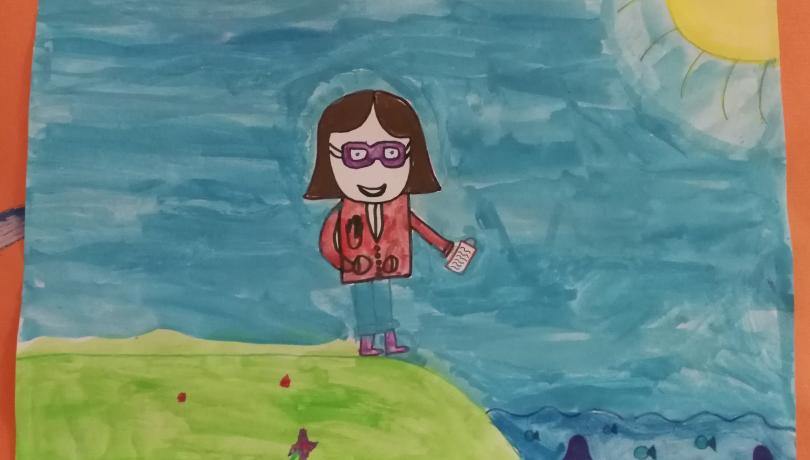We talk about the actions that can be promoted from a public marine research and innovation center committed to equality.

Writing this text from the context of a marine research center, we could think of a metaphor between the construction of learning -how we acquire knowledge- and the acquisition of nutrients -the filter feeding of some aquatic organisms-. You have probably heard that “boys and girls are like sponges” since they “absorb everything”.
Like many characteristics attributed to childhood, this is not something unique to the childhood stage, but also extends to later stages because learning is continuous throughout people’s lives. With regard to the construction of learning, the environment and the stimuli we receive through it play a fundamental role.
Continuing with the metaphor, the filter organisms that live in the sea absorb nutrients -and oxygen- that help them stay alive and grow. However, they also inevitably ingest the pollutants that are in the water. In fact, sponges are very good bioindicators, since they also incorporate these substances that not only do not feed them, but also are harmful for them. Based on this idea, I will try to explain how equality can be promoted from a research center.
We build, as we have said, our ideas through what we perceive from the environment that surrounds us and to which we have access. This does not include only a unique reality of each individual, but a whole social imaginary to which a lot of attention should be paid, since very often differs markedly from this imaginary and it is necessary to review the concepts.
The collective imaginary refers to the set of values, institutions, laws and symbols with which people relate to something. What means to be a woman? What means to be a man? What means to be a scientist? We agree on the fact that in a good part of the possible answers to these questions, there is a certain common agreement, a collective imaginary that more or less correspond to reality and that is explained like this in the most typical environments of formal education – schools, institutes and universities – and non-formal – museums, environmental education centers or the media.
However, each person, on their personal level, they have just finished to built their own answers influenced by their experience and there is where the Institut de Ciències del Mar can contribute with its grain of sand when the center interacts with citizenship.
What can the ICM-CSIC do for equality from education?
At the ICM-CSIC we produce information at many levels: written -scientific publications, books, reports, educational or informative materials, etc.-, oral -visits to the research centre, visits to educational centres, internal and external communication, etc.- and visual -websites, posters, events, etc.
We should keep in mind what communication we do and how we do it, since this influences in how citizens and different educational environments perceive marine research and the people who develop it and contributes to creating realities beyond and asking questions such as “what implies being a woman or a man in the field of science”.
For achieving gender equality, the first thing research centres should do is to identify the source of the problem. Until now, numerous studies have demonstrated that sexism exists in society and have identified its origins. This is the first step to overcome inequality. In the same way, to improve the health of marine environments and of filter organisms in polluting environments, the first thing that should be done would be to analyze the medium through which they have previously been feeding.
In the case of equality, everything begins with being aware of the impact that our words, gestures, actions or decisions can have and reviewing them and acting accordingly. Currently, the European Commission, aware of the importance of achieving gender equality in the field of research, establishes that all research centres that want to access to European funds need to carry out a diagnosis and develop an action plan to achieve this goal, obeying European guidelines.
At the ICM-CSIC we have already taken the first step forward and we have drawn up our own Gender Equality Plan, which identifies a series of lines of action both in the field of education and in others.
This is in line with the 2030 Education Agenda, which recognizes that gender equality requires an approach “that ensures that girls and boys, women and men not only have access to and complete educational cycles, but are also equally empowered in and through education”. Consequently, there are more and more educational centres that consider the gender perspective and work towards equality through specific actions provided for in educational programs.
For this reason, at the ICM-CSIC we try to keep all this in mind in the educational acts and actions that we carry out, which implies putting on purple glasses when explaining concepts and encouraging both girls and boys from realistic perspectives, showing referents of both sexes that help them achieve goals or clarify what they want to do or not to do.
Another problem to address within the field of education is gender violence, which is still very present in our society. In this sense, there is a whole phenomenon, school-related gender-based violence (SRGVB). It is not a new challenge, it is a pending issue that we have been dragging for many years, but that we can solve by proposing changes that lead us towards a fairer society. At the ICM-CSIC we firmly defend the expression “act locally, but think globally”, as it is also key to improving the current state of the ocean.
And it is that some local and day-to-day decisions can have global consequences and it is only our responsibility to decide how we act, being aware of the global impact that these actions can have. In the same way, to achieve equality it is necessary to keep this in mind and act accordingly in order to get closer and closer to real equality.